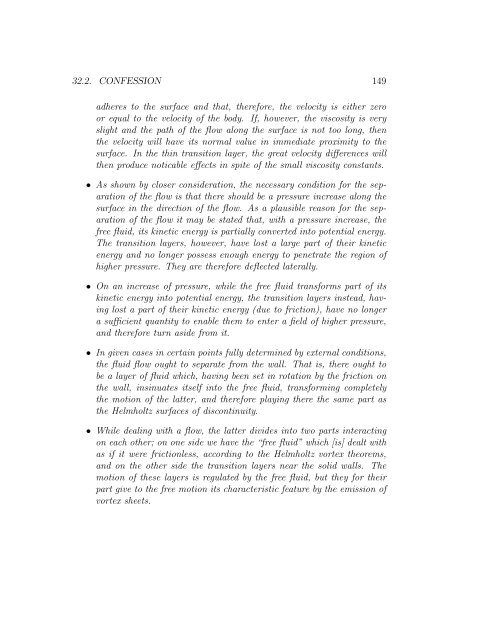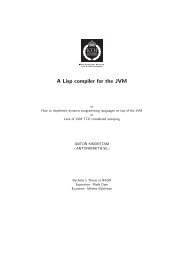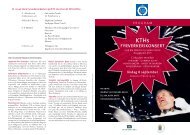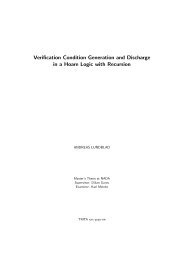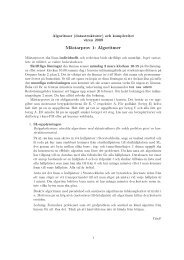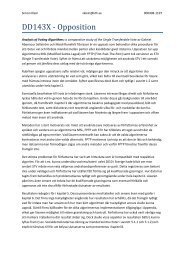Dr Faustus of Modern Physics - Department of Speech, Music and ...
Dr Faustus of Modern Physics - Department of Speech, Music and ...
Dr Faustus of Modern Physics - Department of Speech, Music and ...
You also want an ePaper? Increase the reach of your titles
YUMPU automatically turns print PDFs into web optimized ePapers that Google loves.
32.2. CONFESSION 149<br />
adheres to the surface <strong>and</strong> that, therefore, the velocity is either zero<br />
or equal to the velocity <strong>of</strong> the body. If, however, the viscosity is very<br />
slight <strong>and</strong> the path <strong>of</strong> the flow along the surface is not too long, then<br />
the velocity will have its normal value in immediate proximity to the<br />
surface. In the thin transition layer, the great velocity differences will<br />
then produce noticable effects in spite <strong>of</strong> the small viscosity constants.<br />
• As shown by closer consideration, the necessary condition for the separation<br />
<strong>of</strong> the flow is that there should be a pressure increase along the<br />
surface in the direction <strong>of</strong> the flow. As a plausible reason for the separation<br />
<strong>of</strong> the flow it may be stated that, with a pressure increase, the<br />
free fluid, its kinetic energy is partially converted into potential energy.<br />
The transition layers, however, have lost a large part <strong>of</strong> their kinetic<br />
energy <strong>and</strong> no longer possess enough energy to penetrate the region <strong>of</strong><br />
higher pressure. They are therefore deflected laterally.<br />
• On an increase <strong>of</strong> pressure, while the free fluid transforms part <strong>of</strong> its<br />
kinetic energy into potential energy, the transition layers instead, having<br />
lost a part <strong>of</strong> their kinetic energy (due to friction), have no longer<br />
a sufficient quantity to enable them to enter a field <strong>of</strong> higher pressure,<br />
<strong>and</strong> therefore turn aside from it.<br />
• In given cases in certain points fully determined by external conditions,<br />
the fluid flow ought to separate from the wall. That is, there ought to<br />
be a layer <strong>of</strong> fluid which, having been set in rotation by the friction on<br />
the wall, insinuates itself into the free fluid, transforming completely<br />
the motion <strong>of</strong> the latter, <strong>and</strong> therefore playing there the same part as<br />
the Helmholtz surfaces <strong>of</strong> discontinuity.<br />
• While dealing with a flow, the latter divides into two parts interacting<br />
on each other; on one side we have the “free fluid” which [is] dealt with<br />
as if it were frictionless, according to the Helmholtz vortex theorems,<br />
<strong>and</strong> on the other side the transition layers near the solid walls. The<br />
motion <strong>of</strong> these layers is regulated by the free fluid, but they for their<br />
part give to the free motion its characteristic feature by the emission <strong>of</strong><br />
vortex sheets.


